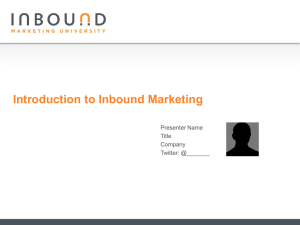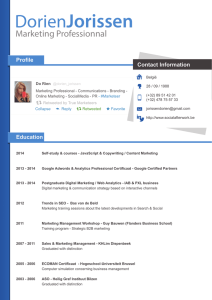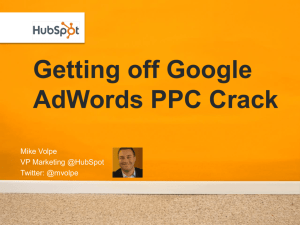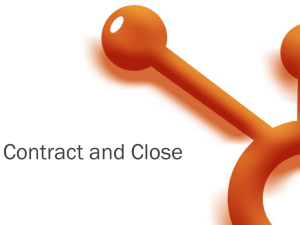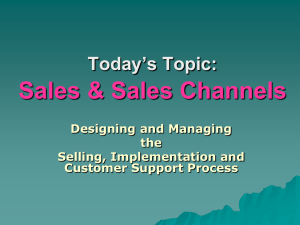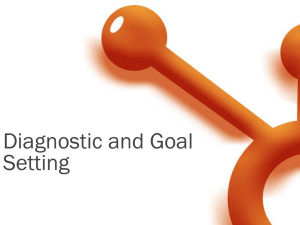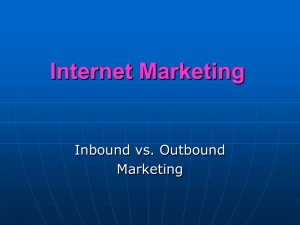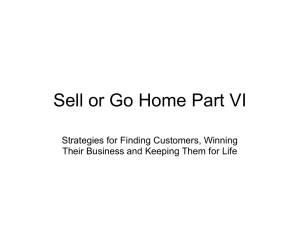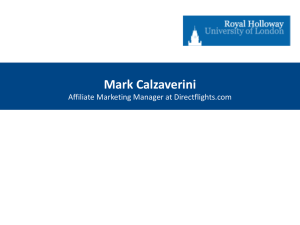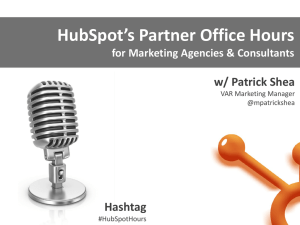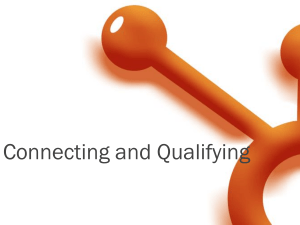Kyle Cossanos Real Estate Marketing Presentation
advertisement
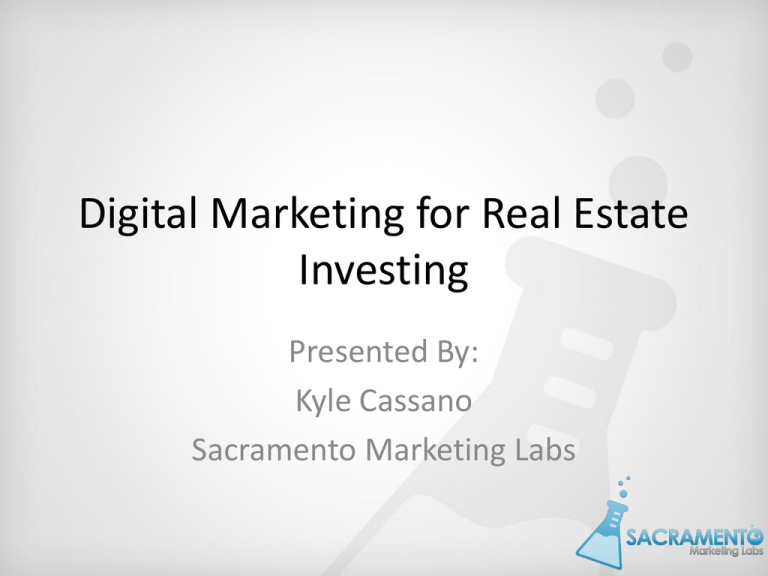
Digital Marketing for Real Estate Investing Presented By: Kyle Cassano Sacramento Marketing Labs Who am I? I am Kyle Cassano I help business owners, entrepreneurs, and companies Increase Sales In order to grow their businesses and increase profit! Educational Credentials Strategic Communications (Public Relations) Master of Business Administration Professional Social media and digital marketing strategist for 5 years working within many industries. Organizations I currently serve as a: Marketing Committee Member for United Way California Capital Region Community Outreach Committee Member for Shriners Hospital for Children – Northern California Media Sacramento Marketing Labs been featured in / mentioned by: Digital Marketing Challenges Digital Marketing: Challenges • • • • • • Social Media Overload Understanding Social Media Ranking for Keywords Productivity & Time Management Measuring & Monitoring Making Enough Money Digital Marketing: Challenges Social Media Overload – It can be overwhelming for newcomers. How do you keep up? • E-Reader App – Pulse • Stay informed. Keep your ear to the streets! – Mashable – Social Media Examiner – HubSpot Digital Marketing: Challenges Understanding Social Media – Knowing social media well enough to recognize opportunities. • Personal use first – 20 mins/day for 1 wk – Get familiar with the features and make mistakes Which channels to use? • Start with the big guys – Facebook, Twitter, YouTube – These channels have the most users and eyeballs • Embrace the little guys – Instagram, Vimeo, Pinterest – Create an account for personal use and spend 20 mins a day for one week Digital Marketing: Challenges Ranking for Keywords – Getting enough traffic to generate leads. Get found online when people are searching for the services you offer. • SEO – On-Page Optimized? – Off-Page Optimized? – YouTube Videos? • Low conversion rates make it necessary to have high traffic volumes • It is difficult to get high traffic when you’re first starting to build a following – Convert with content! Digital Marketing: Challenges Productivity & Time Management – Finding the time. How to manage all your social media in 20 minutes a day? • • • • • • Schedule Posts (Sendible) Set a Time to Check All Accounts (Hootsuite) Allot 20 Minutes of Time Each Day Focus the Majority of Your Time Where it Counts Outsource to a Professional / Agency Use an online marketing platform (Hubspot) Digital Marketing: Challenges Measuring & Monitoring – Knowing if it is working. If you’re not measuring, you’re not marketing. • Google Analytics – Website Traffic & Referral Traffic • Facebook Insights – Facebook’s Analytics Platform • Sendible & HubSpot – Listening & Monitoring Digital Marketing: Challenges Having Consistent Revenue Growth • You need to consistently generate sales/revenue • Your website needs a lot of continuous traffic • Your website needs to rank for relative keywords that have high search volume • Your website should apply every sales tactic • You should be doing this on a daily basis Overcoming the Challenge Overcoming the Challenge Fortunately, digital marketing challenges in REAL ESTATE are simpler to overcome, versus challenges in most other industries. WHY? Overcoming the Challenge • • • • Buyers are often Highly Motivated Low Traffic Requirements (compared to most industries) Easy to Rank for quality Keywords (Intent to Purchase) Property is a Big-Ticket Item Overcoming the Challenge Buyers are often Highly Motivated • Time sensitive / urgent need to secure a home • Buyers have the money • Sale cycle / Closing cycle is short Overcoming the Challenge Low Traffic Requirements (compared to most industries) • You don’t need a lot of traffic if your website’s conversion rate is high - capture most of the people who are looking for your properties. Overcoming the Challenge Easy to Rank for quality Keywords (Intent to Purchase) • Depending upon location you might benefit from owning a less competitive keyword. • “South Land Park Homes for Sale” • “Curtis Park Homes for Sale” Overcoming the Challenge Property is a Big-Ticket Item • ROI comes after a single sale • Example: You brokered a 5-year lease on a 2400 sq ft commercial space in Downtown Sacramento for which you will receive a 5% commission on total term amount ($259,200). Rent is $1.80 sq ft, or $4,320/mo. As the broker you will receive a commission of $12,960. Overcoming the Challenge So many different opportunities / areas • • • • • Residential Rentals Residential Sales Commercial Rentals Commercial Sales Different Local Markets The Strategy The Strategy Your digital marketing strategy should consist of inbound and outbound tactics, that align with your traditional marketing strategy. 1. Inbound – SEO and Social media 2. Outbound – Publicity from Speaking and Media opportunities The Planning The Planning Planning – 5 Things You Must Know Before You Start 1. Why are you going into social media? 2. How does your social media plan support you overall marketing plan? 3. How are you going to represent your brand online? 4. Who is your audience and where do they live online? 5. How will you measure success? The Planning 1. Why are you going into social media? • What's your company's purpose in getting into social media? • Are you there to retain and talk with existing customers? Protect your brand's reputation online? Find new customers and improve sales? The Planning ACTION STEP 1 • Task: Create a list of the key reasons why you're joining a social media site. Be specific about the outcomes you hope to achieve. The Planning 2. How does your social media plan support you overall marketing plan? • • • • How will your social media outreach affect your marketing? Will you be selling via your social presence? Tweeting deals on a regular basis? How will you be tracking these efforts, and comparing them to other marketing and sales efforts? The Planning ACTION STEP 2 • Task: If your customer service group or sales organization will be affected by your new social tools, take the time to talk with them and ensure everyone is on the same page. Write down specifics on how your social plan supports your marketing. The Planning 3. How are you going to represent your brand online? • Will your company's presence contain an icon, or the picture of a person? • Who will be the voice of the business? • Will a principal of the firm be both the owner of the business and the main social contact, or will you create accounts that represent your brand? The Planning ACTION STEP 3 • Task: Brainstorm with your marketing advisors about how your company will represent itself, before you launch. The Planning 4. Who is your audience and where do they live online? • Where do they spend time online? • Social media is global. Are you going to talk with everyone, gather a large following, or are you going to focus on just your local customer base? • Will you "follow back" or "Friend" everyone online who connects to you, or just some of them. Who? The Planning ACTION STEP 4 • Task: Research your audience and write up your policy. There are many online resources for creating a social media policy. The Planning 5. How will you measure success? • For some, success is making the cash register ring and that's it. Those firms will have to track metrics and watch to see if posts in social media bring customers in and help them convert. • For others, social is about building up a brand name, satisfying customers, or generating inquiries or names on an email list. The Planning ACTION STEP 5 • Task: Pick a few measurements and set up a way to track your progress, even if it is a simple spreadsheet that shows growth of fans over time. Track time spent on social and make sure the metrics are proving out the investment. The Inbound Marketing Source: Hubspot The Inbound Marketing What is Inbound Marketing? Creating and sharing content with the world via comprehensive SEO and Social Media Strategy. • • • • • Content Creation Lifecycle Marketing Personalization Multi-channel Integration Source: Hubspot The Inbound Marketing Content Creation You create targeted content that answers your customer's basic questions and needs, and you share that content far and wide. Source: Hubspot The Inbound Marketing Lifecycle Marketing You recognize that people go through stages as they interact with your company, and that each stage requires different marketing actions. Source: Hubspot The Inbound Marketing Personalization As you learn more about your leads over time, you can better personalize your messages to their specific needs. Source: Hubspot The Inbound Marketing Multi-channel Inbound marketing is multi-channel by nature because it approaches people where they are, in the channel where they want to interact with you. Source: Hubspot The Inbound Marketing Integration Your publishing and analytics tools all work together like a welloiled machine, allowing you to focus on publishing the right content in the right place at the right time. Source: Hubspot The Inbound Marketing The Four Marketing Actions Source: Hubspot The Inbound Marketing Attract Some of the most important tools to attract the right users to your site are: Blogging - A blog is the single best way to attract new visitors to your website. Create educational content that speaks to them and answers their questions. Social Media - You must share remarkable content and valuable information on the social web, engage with your prospects, and put a human face on your brand. Interact on the networks where your ideal buyers spend their time. Keywords - Your customers begin their buying process online, usually by using a search engine to find something they have questions about. So you need to make sure you’re appearing prominently when they search. Source: Hubspot Pages - You must optimize your website to appeal to and speak with your ideal buyers. The Inbound Marketing Convert Some of the most important tools in converting visitors to leads include: Calls-to-Action - Calls-to-action are buttons or links that encourage your visitors to take action – Contact Us Now! Landing Pages - When a website visitor clicks on a call-toaction, they should then be sent to a landing page. A landing page is where the offer in the call-to-action is fulfilled, and where the prospect submits information that your sales team can use to begin a conversation with them. Forms - In order for visitors to become leads, they must fill out a form and submit their information. Optimize your form to make this step of the conversion process as easy as possible. Source: Hubspot Contacts - Keep track of the leads you're converting in a centralized marketing database. The Inbound Marketing Closing tools include: Close Lead Scoring - You’ve got contacts in your system, but how do you know which ones are ready? Using a numerical representation of the sales-readiness of a lead takes the guesswork out of the process. Email - What do you do if a visitor clicks on your call to action, fills out a landing page, but still isn’t ready to become a customer? A series of emails focused on useful, relevant content can build trust with a prospect and help them become more ready to buy. Marketing Automation - This process involves creating email marketing and lead nurturing tailored to the needs of the lead. Source: Hubspot Closed-loop Reporting - Integration with your (CRM) system allows you to analyze just how well your marketing and sales teams are playing together. The Inbound Marketing Tools used to delight customers include: Delight Smart Calls-to-Action – These present different users with offers that change based on buyer persona and lifecycle stage. Social media – Using various social platforms gives you the opportunity to provide real-time customer service. Email and Marketing Automation – Providing your existing customers with remarkable content can help them achieve their own goals, as well as introduce new products and features that might be of interest to them. Source: Hubspot The Outbound Strategy Outbound Marketing (Traditional) • Buying ads, email lists, and leads • Publicity from Speaking and Media • TV and Radio Commercials The SEO The SEO SEO is the single best investment that a local business can make. WHY? The SEO Benefits • It is low cost marketing • It increases website traffic • 97% of consumers search online to Shop Locally for products, services and information, According to BIA/Kelsey and ConStat • A website can rank for multiple keywords • About 75% of searchers click on “Organic” listings vs. Paid advertisements • It encompasses many of the elements that make up, and lead to Inbound marketing success • More cost effective than PPC (PPC vs. SEO) What is Search Engine Optimization SEO? SEO is the process of getting traffic from the “organic,” “editorial” or “natural” listings on search engines. What is Search Engine Optimization SEO? On-Page & Off-Page techniques to help get your website ranked higher in the search engines. What is Search Engine Optimization SEO? On-page factors – 25-30% (Content) Off-page factors – 70-75% (Links) Local SEO SEO + Local Search Local SEO Why should you care about local search? FACT: Internet search is how people search for local businesses today, as traditional methods are becoming obsolete. FACT: Your prospects and potential customers are actively searching for your products/services online. Local SEO Local search is a search term + geo modifier. Examples: “real estate agent” (Google knows your location) “real estate broker sacramento” “houses for sale sacramento” Think about the best feature of PPC (geo-targeting) with the power of organic ranking (highly visible and trusted), that is local search. Local SEO This is how local results are displayed. Google believes this user is looking for local referrals and shows the map, along with local search results. This is the result of Google Authorship and blogging. The Importance of Position The Importance of Position Getting Started 4 Steps to SEO Success 1. 2. 3. 4. Finding your keywords On-Page Optimize your website Off-Page Optimize – Blogging & Link building Measure Success 1. Keyword research What is your audience searching for? Choosing the Right Keywords Basic Keyword research • Traffic - # of Searches - Google Adwords Tool • Relevancy – Are they relevant to your services? • Competition – low - high Consider While Choosing Commercial intent, purchase intent, long-tail vs. short, keyword competition, using tools like Google Wonder Wheel and AdWords. 2. Optimize Your Website • Domain Name • Page Title • Anchor Text • Meta Description • Tags • Page Text (Bold or Keyword Density) • Meta Descriptions • Keywords • Alt text on images (SEO friendly images) 3. Blogging & link Building • • • • • • • • • • • • Link Popularity analysis Competition analysis Link building One way links Reciprocal links Multiple way links Search engine submission Directory submission Press release submission Article submission Social media optimization Participation in blogs, forums, online community and discussion boards 4. Measure Success • Keyword Rakings in SERPs • Organic Traffic to website – Has it increased? • Sales – Have they increased? • Ask your customers how they found you Q&A kyle@SacMarketingLabs 916.822.2033 Ext 1001

